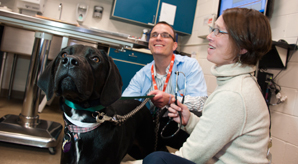

As the number of overweight and obese Americans continues to grow -- now at 68 percent of the population – the incidence of obesity in our furry family members also is a growing concern. The American Veterinary Medical Association estimates 35 percent of our pets are overweight or obese. For our pets, just like us, that means a high price to pay in health and quality of life.
Some of our dogs and cats are living in chronic pain due to the excess weight they carry, and weight loss is one of the safest ways to help alleviate this type of pain.Overweight dogs are more likely to suffer from joint disease, respiratory disease, and other preventable conditions. Overweight cats can be at risk for diabetes and some types of liver disease. These conditions can have devastating consequences and become financially challenging for owners. Managing your pet’s weight is important to their overall health and lifelong wellness.
Recognizing if your pet is overweight is half the challenge. Dogs and cats come in all sorts of shapes and sizes, so coming up with an ideal weight in pounds is not always practical. The Body Condition Score System focuses on the amount of skin and tissue that can be felt over the ribs, as well as the shape over the waist and underbelly. A dog or cat with an ideal body condition will have a visible waist behind the ribs when viewed from above; the ribs can be felt through only small amount of fat; and, when viewed from the side, the underbelly will be tucked up. Your veterinarian can provide guidance in determining an ideal body weight for your pet.
Helping your pudgy pup or fat cat lose weight can be challenging but very rewarding when your pet’s pain decreases, energy increases, and level of fitness improves. A successful weight loss program addresses two major components: the amount of food your pet is eating and their activity level to use those calories. Work with your veterinarian to identify how many calories you should be feeding your pet. Your first step is to identify exactly how much food is being fed. Start by using a measuring cup and then identify other sources of calories, such as treats. It’s important for your entire family to get on board and help your pet be successful, so no sneaking treats underneath the table – no matter how sad those brown eyes look. Look for ways to increase activity level such as encouraging your cat to chase toys or taking your dog for a walk. Weight loss can be slow, but with patience and persistence your efforts (and your pet’s) will pay off and add healthier years to your pet’s life.
Critter Corner is being brought to you by the CSU Veterinary Teaching Hospital Community Practice clinicians and staff. World-class veterinary care in your neighborhood. http://csuvth.colostate.edu/